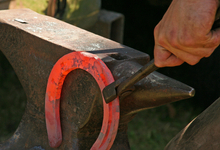Using a new technique to prevent lameness in horses, Patrick T. Reilly, a farrier at Penn Vet has a goal of making better shoes to treat and prevent various forms of lameness in the same way a podiatrist crafts orthotic footwear for humans.

Custom shoes - A bonus for lame horses
Penn Vet farrier, Patrick T. Reilly, uses film imprints to make better shoes to treat and prevent lameness in the same way a podiatrist crafts orthotic footwear for humans.
Reilly is more than a farrier. He also runs a research lab and teaches at the University of Pennsylvania School of Veterinary Medicine, where he hopes the use of a new force-sensing film will help him in a big quest.
In spite of crooked legs and uneven front hooves, a 1,200-pound horse walks and jumps just fine - at least as far as Patrick T. Reilly can tell by looking.
In assessing the horse's movements, Reilly does something almost unheard of in equine care. He fits a thin plastic film onto the horse's left front hoof, attaches it to a small electronic recording device, and measures the forces on the animal's foot as it walks around the barn. By measuring the forces on the horse's foot, he is able to design custom shoes that help prevent lameness.
His prime target is laminitis, a poorly understood, crippling disease that has plagued horses - and their owners - for centuries. The illness involves painful inflammation and, in severe cases, separation of the hoof from the foot.
After colic, laminitis is the second most common reason that horses are euthanized, as happened with its most famous victim, Barbaro."Every year when the Triple Crown comes around, I'm thinking to myself, 'What would I do differently if I was presented with another challenge?' " said Reilly, who helped care for the 2006 Kentucky Derby winner. "It's a yearly reminder of the need to get better."
In addition to being a farrier, Reilly is a historian and researcher, seeking to improve his trade both through modern technology and by studying old horseshoes from the 19th century - in hope of rediscovering expertise from the days when the horse was a primary engine of the U.S. economy.
Penn's vet school is one of the few with a farrier on staff, allowing Reilly to provide a bridge between science and the barn, said Jeffrey Thomason, a professor at the Ontario Veterinary College at the University of Guelph in Canada.
Reilly's aim is to make a shoe to better ease pressure on the hooves of a lame horse, allowing it to recover.
